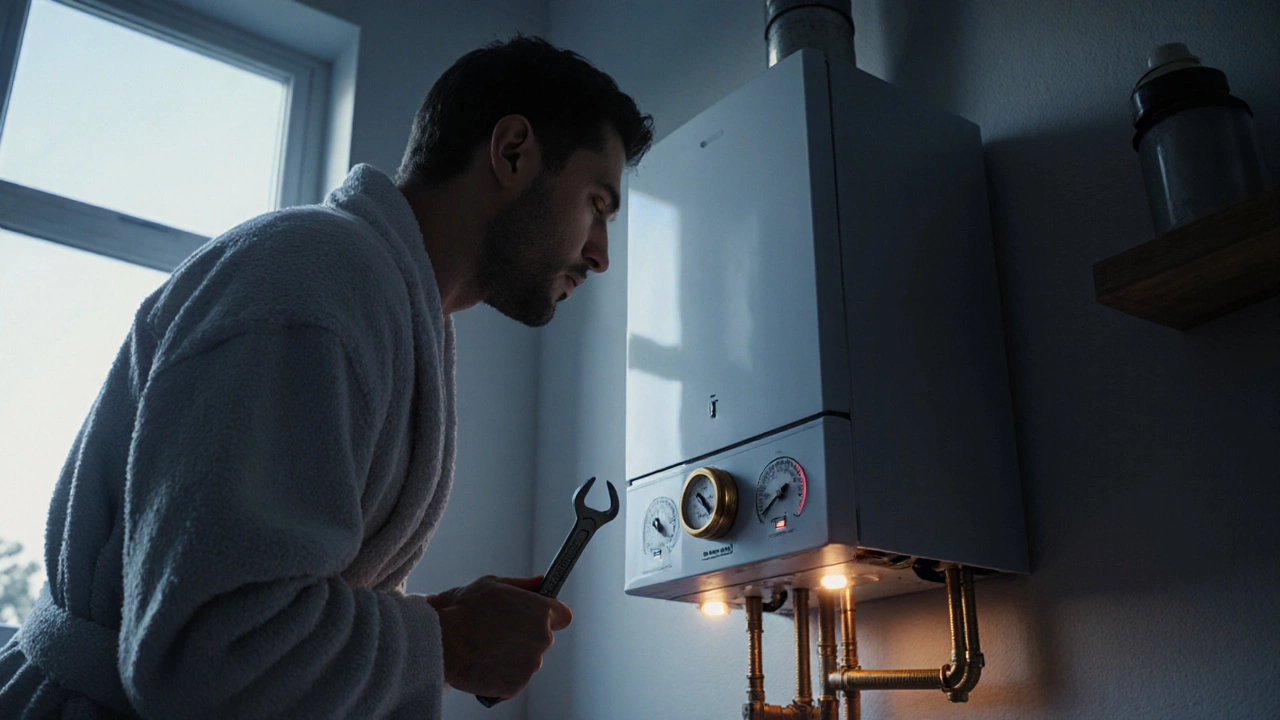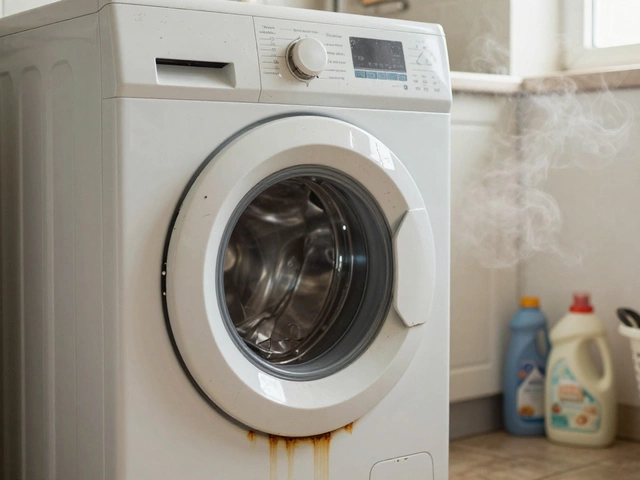Most call-outs I see boil down to a short list: no heat or hot water, low pressure, leaks, strange noises, and ignition faults. The good news? A chunk of these are quick wins you can sort safely before paying for a technician. The catch is knowing where the DIY line ends-because gas, flues, and sealed compartments are not a “have a crack” situation in New Zealand. I’ll walk you through the biggest culprits, the fast checks that work, what’s pro territory, and how to keep your system steady through the year. I live in Auckland, and even here-where freezes are rare-my dog Rex still reminds me when the radiators aren’t pulling their weight.
TL;DR:
- The most common issues: no heat/hot water, low/high pressure, leaks, ignition lockouts, cold radiators, kettling noises, and thermostat faults.
- Safe quick checks: power, gas supply, thermostat/programmer settings, pressure (aim ~1.0-1.5 bar cold), bleed radiators, reset once.
- Stop and call a pro if: you smell gas, see a persistent leak, pressure climbs past 2.5 bar when hot, or the boiler keeps locking out.
- In NZ, only a licensed gasfitter may open the boiler case or work on gas/flue parts (per the Plumbers, Gasfitters and Drainlayers Board).
- Prevention: yearly service, keep the condensate line clear, fit inhibitor for hydronic systems, and check pressure monthly.
The most common boiler problems (and what they usually mean)
If you’re Googling common boiler problems, odds are you’re dealing with one of these. I’ll list the tell-tale signs, the likely cause in plain English, and what’s safe to try.
- No heat or no hot water
Usual suspects: Tripped power or gas supply off, low system pressure, failed ignition, a stuck diverter valve (combi), or a dead circulation pump (system/regular boilers). A bad thermostat/programmer can mimic all of the above.
Quick check: Power on? Gas meter open? Thermostat calling for heat? Pressure at 1.0-1.5 bar when cold? Try one reset. If it relights then dies, call a pro. - Boiler losing pressure
Usual suspects: Minor leak in the system (valves or radiators), a dripping pressure relief valve (PRV), or a flat expansion vessel. Bleeding radiators without topping up can also drop pressure.
Quick check: Look for damp patches under the boiler and radiators. If you know your filling loop, you can repressurise to ~1.3 bar cold. If pressure keeps dropping, don’t keep topping up-find the leak or call a pro. - Boiler pressure too high
Usual suspects: Overfilled system, stuck filling loop, or expansion vessel failure. Repeated pressure spikes can pop the PRV and cause leaks.
Quick check: Ensure the filling valves are fully closed. If it still climbs above ~2.5 bar when hot, you need a gasfitter to assess the vessel and PRV. - Leaking boiler
Usual suspects: Perished seals, corroded heat exchanger, loose compression fittings, or a dripping PRV. Leaks get worse under heat and pressure.
Quick check: Place a dry tissue at visible joints to spot fresh moisture. Switch off, isolate the water if needed, and book a repair. Do not open the case. - Kettling or banging noises
Usual suspects: Limescale/sludge restricting the heat exchanger, air in the system, or pump on the wrong speed. The boiler overheats locally and “boils,” hence the kettle sound.
Quick check: Bleed radiators. If you’re in a hard-water area (e.g., parts of Canterbury), ask about descaling or a system clean with inhibitor. - Radiators cold at the top or one room never warms
Usual suspects: Air in radiators, unbalanced system, sticky TRVs, or sludge in certain runs. On combis, a stuck diverter valve can favour hot water over heating. Quick check: Bleed cold-top radiators; then recheck pressure and top up. Balancing (throttling hotter radiators) is methodical but doable. - Ignition lockouts and error codes
Usual suspects: No flame sensed, faulty igniter, gas valve issue, flue or condensate blockage. Some brands show codes like F28/F29 (failed ignition) or E133 (similar).
Quick check: Check gas supply at another appliance, verify condensate pipe isn’t blocked, and try one reset. Persistent lockouts = pro job. - Frozen condensate pipe (cold regions)
Usual suspects: Outdoor condensate line froze, boiler trips on safety. It’s rare in Auckland but common in inland South Island cold snaps.
Quick check: Pour warm (not boiling) water over the external pipe, lag it with insulation, and reroute internally if possible for a permanent fix. - Thermostat or programmer not behaving
Usual suspects: Flat batteries, schedules set to “holiday,” or the thermostat in a hot spot (above a heater or in direct sun). Smart thermostats can drop Wi‑Fi and default to odd schedules.
Quick check: Replace batteries, set a simple schedule, move freestanding stats away from heat sources, and update firmware.
A note on safety and law in New Zealand: Any work on gas components, flues, or inside the boiler case must be done by a licensed gasfitter under the Plumbers, Gasfitters and Drainlayers Act. WorkSafe NZ advises installing and testing carbon monoxide alarms if you use fuel-burning appliances. If you smell gas, turn the supply off at the meter if safe, ventilate, avoid switches, and call your gas emergency line.
Quick, safe checks you can do before calling a pro
These steps catch the common, harmless gotchas. You won’t touch gas or open the boiler case.
- Power and settings
Confirm the boiler is powered (display lit), the fused spur is on, and the consumer unit hasn’t tripped. On the programmer, set a simple “On” schedule. Turn the room thermostat up to max as a test. - Gas supply
Check another gas appliance (like a hob) to confirm gas is available. If it’s out house‑wide, it’s a supply issue. If it’s only the boiler, note the error code and move on. - System pressure
Look at the gauge: when the system is cool, aim for ~1.0-1.5 bar. If it’s low, top up using the filling loop to ~1.3 bar, then bleed radiators if needed, and top up again. If it’s high (>2.2 bar cold), don’t drain randomly-call a pro to check the expansion vessel. - Bleed radiators
If the top is cold and the bottom is hot, you have air. Use a radiator key and a towel. Open the valve slowly until air hisses and water follows. Close the valve and recheck boiler pressure. - Condensate and flue
Make sure the condensate pipe exits are not blocked with muck or ice. The flue terminal should be clear of leaves and nests. Don’t dismantle anything-just clear obvious obstructions. - Reset once
Use the boiler’s reset per its manual. If it locks out again quickly, note the code and stop. Repeated resets can mask dangerous faults. - Thermostat sanity check
Replace batteries, bypass complex schedules, and test in “manual heat” mode. For smart stats, reboot the hub and check the app shows a heat call.
Rule of thumb: if a quick check fixes it and the boiler behaves for a full heating cycle, you’re fine. If it returns within hours or you’re topping up pressure every day, you’ve got an underlying fault worth fixing properly.
DIY vs pro: what to fix, typical NZ costs, and how long it takes
Knowing where to draw the line saves money and risk. In New Zealand, gas and sealed-case work is pro-only. Here’s a practical guide to common scenarios.
| Symptom | Likely cause | Quick check | DIY? | Typical NZ repair cost (parts+labour) | Time to fix |
|---|---|---|---|---|---|
| No heat/hot water | Low pressure, thermostat off, ignition fault | Top up to ~1.3 bar, reset once | Partial | $0-$80 (DIY) / $220-$480 (ignition part) | DIY minutes / Pro 1-2 hrs |
| Pressure drops daily | Minor system leak or PRV weeping | Check for damp, valve caps | No | $240-$650 (trace+fix), add $90-$180 sealant if used | 2-4 hrs |
| Pressure high (>2.5 bar hot) | Overfilled or failed expansion vessel | Confirm filling loop closed | No | $280-$680 (recharge/replace vessel) | 1-2 hrs |
| Leaking at joints | Loose compression fittings/seals | Tissue test for fresh moisture | No | $220-$520 (seal/fitting) | 1-2 hrs |
| Kettling noise | Limescale/sludge | Bleed rads, water looks dirty? | No | $350-$1,200 (clean/descale) | 2-6 hrs |
| Cold top radiators | Air in system/unbalanced | Bleed, balance | Yes | $0-$50 (DIY tools) | 1-2 hrs DIY |
| Ignition lockouts | Flame sensor, igniter, gas valve | Gas on, reset once | No | $260-$680 (sensor/igniter), $650-$1,200 (valve) | 1-3 hrs |
| Frozen condensate | External pipe iced | Warm water thaw, insulate | Yes | $0-$80 (lagging) / $200-$450 reroute | 20-40 mins DIY / 1-2 hrs pro |
Notes:
- Prices are ballpark for 2025 in NZD and vary by region and parts availability.
- If your boiler is 12-15 years old and needs a major part (e.g., heat exchanger), ask for a repair-vs-replace quote. The energy savings of a modern condensing model can be significant, especially with good controls.
- Landlords: ensure annual safety checks align with NZ Building Code and manufacturer servicing recommendations. Keep records.
DIY line in the sand in NZ: you may adjust external controls, bleed radiators, repressurise via the filling loop, thaw condensate, and balance radiators. You may not open the boiler case, adjust gas valves, or touch the flue. That’s for a licensed gasfitter per PGDB rules.

Prevention cheat‑sheet: settings, water quality, and service rhythm
Small routines prevent the big, expensive stuff. This is the checklist I actually use at home.
- Monthly (5 minutes)
- Check pressure cold: aim ~1.2-1.4 bar. Top up if below 1.0 bar.
- Walk the system: any green-white crust on joints, damp patches under valves, or musty corners? Catch tiny leaks early.
- Run all TRVs and zone valves from min to max, then set back. Prevents sticking after long idle periods (classic after summer).
- Start of heating season (spring in NZ? Depends how you use it)
- Test both heating and hot water for 20-30 minutes. Listen for unusual noises.
- Bleed radiators, then top up pressure. Label the filling loop if others in the house will use it.
- Smart stat owners: review schedules; heat only when needed. Optimise start/stop.
- Annually (book with a licensed gasfitter)
- Full service: combustion check, flue integrity, condensate trap clean, electrode inspection, seals check, and system water test.
- System water: ask for inhibitor levels checked and topped up. If water is dirty, consider a clean and magnetic filter install.
- Expansion vessel: check pre‑charge. A flat vessel is behind many pressure yo‑yo problems.
- Hard‑water areas
- Consider scale control (softening or chemical). In Christchurch and parts of Canterbury, kettling shows up earlier without it.
- Descale on service intervals if your model is prone to fouling.
- Cold‑climate tweaks (South Island)
- Insulate external condensate lines with thick lagging; increase pipe diameter; route internally where possible.
- Set anti‑freeze mode if your controls offer it. It cycles pumps to prevent freezing.
Heuristics that help:
- If the gauge rises more than ~1 bar from cold to hot, suspect the expansion vessel.
- If you bleed more than 2-3 radiators, expect to top up pressure after each one.
- Repeat lockouts within an hour usually point to ignition/flame sense or a blocked condensate-not a one-off glitch.
- One cold radiator on a long run often needs balancing, not a new pump.
Real‑world examples and quick scenarios
Here’s how these play out in normal homes-no lab talk, just what I see on jobs and at my own place.
- The post‑summer surprise (Auckland)
You switch heating on for the first chilly night. Hot water is fine, radiators stay cold. Pressure is normal. Likely a combi diverter valve that stuck after months of only hot water use. Cycling the heating a few times and running the valve from closed to open can free it briefly, but it will usually stick again. Book a visit; a diverter service/replacement is 1-2 hours. - Kettling in a hard‑water pocket (Canterbury)
Boiler whistles, then clanks when it fires. Radiators heat slowly. Bleeding helps a touch. A scale/sludge treatment plus a magnetic filter calms it down and protects the heat exchanger. Plan half a day and $600-$1,000 depending on the method. - Frozen condensate on a frosty Queenstown morning
Boiler tries to start, then flashes an ignition/condensate fault. Outside pipe is white with ice. Warm water thaw, reset, and add thick insulation. Long term, reroute internally to the nearest waste if possible. - Intermittent lockouts, sunny living room
The thermostat sits above a console that hides a radiator. The room reads 23°C while the rest of the house is 18°C. Moving the stat away from heat sources solves the “mystery” lockouts. - Pressure rollercoaster after a big bleed
You bled six radiators and forgot to top up in between. The boiler now refuses to fire. Bring it back to ~1.3 bar cold and it starts right up. If pressure drops again tomorrow, look for a small leak or a weeping PRV.
Simple decision path for “no heat/hot water”:
- Power on and thermostat calling? If no, fix that first.
- Pressure 1.0-1.5 bar and gas available elsewhere? If no, correct it.
- Reset once. If it runs a full cycle, keep an eye on it. If it locks out again, note the code and call a pro.
Mini‑FAQ: fast answers to the follow‑ups you probably have
- What pressure should my boiler be?
About 1.0-1.5 bar when the system is cold. It will rise when hot. Regular spikes above 2.5 bar point to an expansion vessel or PRV issue. - Is it safe to keep topping up pressure?
It’s ok after bleeding or a one‑off drop. If you’re topping up every few days, you’re masking a leak and adding oxygen to the system water. Get it checked. - Why are some radiators hot and others cold?
Air pockets or poor balancing. Bleed first, then balance by slightly closing hotter radiators so cooler ones get flow. - Do I need a carbon monoxide alarm?
If you have fuel‑burning appliances, it’s strongly recommended. Place it per the manufacturer’s instructions. WorkSafe NZ endorses CO safety. - How often should I service the boiler?
Yearly. It keeps efficiency up, catches failing parts early, and is often required to maintain the warranty. - Can I fix a leaking boiler myself?
No. Leaks often involve safety devices and internal seals. Isolate water if needed and call a licensed gasfitter. - My boiler is 15 years old. Repair or replace?
If it needs a major part (heat exchanger, gas valve), get a replacement quote too. New condensing models with smart controls can cut running costs, especially if your old unit is non‑condensing. - Are heat pumps better than boilers in NZ?
Many NZ homes use heat pumps because of our climate and electricity mix. If you already have hydronic heating, a modern boiler with good zoning is still a solid choice. Talk to a local pro about your house and tariffs.
Credibility note: Gas work in NZ is regulated by the Plumbers, Gasfitters and Drainlayers Board. Safety guidance is available from WorkSafe NZ. Manufacturer service schedules (e.g., for Bosch, Rinnai, Vaillant, Ideal) should be followed for your exact model.



